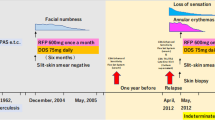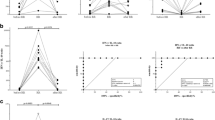Abstract
In this work, we report the existence of enhanced concentrations of IL-2 (Th1 cytokine), TNF-α (mainly a Th1 cytokine), IL-12p40, a strong delayed type hypersensitivity response, and the absence of a serum-specific antibody response (IgG or IgE) in patients with active chiclero’s ulcers. There was a low serum concentration of IL-6 (a Th2 cytokine) that was further reduced once patients healed following antimonial therapy (i.e., 4 months after treatment started). There was an absence of serum IL-4 (a Th2 cytokine) in patients before and after healing. The serum content of nitric oxide, transforming growth factor-β1, and IL-12p70 in patients with progressive chiclero’s ulcers was not different from that of controls. Patients had an alteration in blood-cell counts and showed a poor T cell proliferation after in vitro stimulation with Leishmania mexicana gp63. We concluded that patients with progressive chiclero’s ulcers develop a Th1 type of response at this stage of the disease which correlates with increases in circulating eosinophils and B cells and a reduction of circulating CD8+ T lymphocytes.


Similar content being viewed by others
References
Alexander J, Bryson K (2005) T helper (h) 1/Th2 and Leishmania: paradox rather than paradigm. Immunol Lett 99:17–23
Alexander J, Satoskar AR, Russell DG (1999) Leishmania species: models of intracellular parasitism. J Cell Sci 112:2993–3002
Bacellar O, D’Oliveira A Jr, Jeronimo S, Carvalho EM (2000) IL-10 and IL-12 are the main regulatory cytokines in visceral leishmaniasis. Cytokine 12:1228–1231
Bacellar O, Lessa H, Schriefer A, Machado P, Ribeiro de Jesús A, Dutra WO, Gollob KJ, Carvalho EM (2002) Up-regulation of Th1-type responses in mucosal leishmaniasis patients. Infect Immun 70:6734–6740
Biagi F (1953) Synthesis of 70 case histories of cutaneous leishmaniasis of Mexico (ulcer of the chicle gatherers). Medicina (Mex) 33:385–396
Farajnia S, Mahboudi F, Ajdari S, Reiner NE, Kariminia AA, Alimohammadian MH (2005) Mononuclear cells from patients recovered from cutaneous leishmaniasis respond to Leishmania major amastigote class I nuclease with a predominant Th1-like response. Clin Exp Immunol 139:498–505
Grimaldi G Jr, Soares MJ, Moriearty PL (1984) Tissue eosinophilia and Leishmania mexicana mexicana-eosinophil interactions in murine cutaneous leishmaniasis. Parasite Immunol 6:397–408
Inobe J, Slavin AJ, Komagata Y, Chen Y, Liu L, Weiner HL (1998) IL-4 is a differentiation factor for transforming growth factor-beta secreting Th3 cells and oral administration of IL-4 enhances oral tolerance in experimental allergic encephalomyelitis. Eur J Immunol 28:2780–2790
Katsikis PD, Cohen SB, Londei M, Feldmann M (1995) Are CD4+ cells pro-inflammatory or anti-inflammatory? The ratio of IL-10 to IFN-γ or IL-2 determines their function. Int Immunol 7:1287–1294
Lezama-Davila CM, Gallagher G (1995) CD4+, CD8+ and CD4−CD8− T cell-subsets can confer protection against Leishmania m. mexicana infection. Mem Inst Oswaldo Cruz 90:51–58
Lezama-Davila CM, Williams D, Gallagher G, Alexander J (1992) Cytokine control of Leishmania infection in the BALB/c mouse: enhancement and inhibition of parasite growth by local administration of IL-2 or IL-4 is species and time dependent. Parasite Immunol 14:37–48
Lezama-Davila CM, Isaac-Márquez AP, Padierna-Olivos J, Aguilar-Torrentera F, Chapa-Ruiz R (1998) Immunomodulation of chiclero’s ulcer. Role of eosinophils, T cells, tumor necrosis factor and interleukin-2. Scand J Immunol 47:502–508
Lohoff M, Gessner A, Bogdan C, Rölinghoff M (1998) The Th1/Th2 paradigm and experimental murine leishmaniasis. Int Arch Allergy Immunol 115:191–202
Melby PC, Neva FA, Sacks DL (1989) Profile of human T cell response to leishmanial antigens. Analysis by immunoblotting. J Clin Invest 83:1868–1875
Milon G, Titus RG, Cerottini J, Marchal G, Louis JA (1986) Higher frequency of L. major specific L3T4+ T cells in susceptible BALB/c as compared to resistant CBA/ca mice. J Immunol 136:1467–1471
Modlin RL, Pirmez C, Hoffman FM, Torigian V, Uyemura K, Rea TH, Bloom BR (1989) Lymphocytes bearing antigen-specific γδ T cell receptors accumulate in human infectious disease lesions. Nature 339:544–548
Montenegro J (1926) Cutaneous reaction in leishmaniasis. Arch Dermatol Syphilol 13:187
Moshage B, Kok B, Huizenga JR, Jansen PL (1995) Nitrite and nitrate determinations in plasma: a critical evaluation. Clin Chem 41:892–896
Mosmann TM, Cherwinski H, Bond MW, Giedlin MA, Coffman RL (1986) Two types of murine helper T-cell clone. I. Definition according to profiles of lymphokine activities and secreted proteins. J Immunol 136:2348–2357
Müller I, Louis JA (1989) Immunity to experimental infection with L. major: generation of protective L3T4+ T cell clones recognizing antigens associated with live parasites. Eur J Immunol 19:865–871
Ngo TT, Lenhof HM (1981) New approach to heterogeneous enzyme-immunoassays using tagged enzyme–ligand conjugates. Biochem Biophys Res Comm 99:496–503
Rodriguez-Sosa M, Monteforte GM, Satoskar AR (2001) Susceptibility to Leishmania mexicana infection is due to inability to produce IL-12 rather than lack of IL-12 responsiveness. Immunol Cell Biol 79:320–322
Romagnani S (1994) Lymphokine production by human T cells in disease states. Annu Rev Immunol 12:227–257
Rosas LE, Keiser T, Barbi J, Satoskar AA, Septer A, Kaczmarek J, Lezama-Davila CM, Satoskar AR (2005) Genetic background influences immune responses and disease outcome of cutaneous L. mexicana infection in mice. Int Immunol 17:1347–1357
Satoskar AR, Stamm LM, Zhang X, Satoskar AA, Okano M, Terhorst C, David JR, Wang B (1999) Mice lacking NK cells develop an efficient Th1 response and control cutaneous Leishmania major infection. J Immunol 162:6747–6754
Scharton-Kersten T, Alfonso LC, Wysocka M, Trinchieri G, Scott P (1995) IL-12 is required for natural killer cell activation and subsequent T helper 1 cell development in experimental leishmaniasis. J Immunol 154:5320–5330
Scott P, Natovitz P, Cooffman RL, Pearce E, Sher A (1988a) Immunoregulation of cutaneous leishmaniasis. T cell lines that transfer protective immunity or exacerbation belong to different T helper subsets and respond to distinct parasite antigens. J Exp Med 168:1675–1684
Scott P, Pearce E, Natovitz P, Sher A (1988b) Adoptive transfer of protective immunity against lethal L. major infection with an L3T4+ (Th1) T cell clone recognizing a low molecular weight parasite antigen. FASEB J 2A:1256
Sher A, Coffman RL (1992) Regulation of immunity to parasites by T cells and T cell-derived cytokines. Annu Rev Immunol 10:385–409
Sypek JP, Chung CL, Mayor SE, Subramanyam JM, Goldman SJ, Sieburth DS, Wolf SF, Schaub RG (1993) Resolution of cutaneous leishmaniasis: Interleukin 12 initiates a protective T helper type 1 immune response. J Exp Med 177:1797–1802
Wershil BK, Theodos CM, Galli SJ, Titus RG (1994) Mast cells augment lesion size and persistence during Leishmania major infection in the mouse. J Immunol 152:4563–4571
Xu D, Liu H, Komai-Koma M, Campbell C, McSharry C, Alexander J, Liew FY (2003) CD4+CD25+ Regulatory T cells suppress differentiation and functions of Th1 and Th2 Cells, Leishmania major infection, and colitis in mice. J Immunol 170:394–399
Acknowledgements
The authors wish to thank Dr. Otto Ortega and Dr. Manuel Chan from Programa Corrosión en el Golfo de México and Dr. Narcizo Acuña from Dirección de Estudios de Postgrado e Investigación, Universidad Autónoma de Campeche for the laboratory space provided and for valuable assistance that made part of this work possible. Our gratitude to Departamento de Enfermedades Transmitidas por Vector, Secretaría de Salud, Campeche, for logistic and medical services provided to the patients included in this work. Our thanks go to the staff of Laboratorio de Investigaciones Inmunológicas and Escuela Nacional de Ciencias Biológicas in Mexico city for their kind assistance in performing flow cytometry and proliferation assays. This work was financially supported by Universidad Autónoma de Campeche, Secretaría de Salud del Estado de Campeche. C.M. Lezama-Davila is in receipt of a fellowship from Fundación Pablo Garcia to perform research work as a Scholar Visitor in Dr. Abhay Satoskar’s laboratory at the Microbiology Department, Ohio State University. Finally, the authors want to thank Kimberly Roth for critical reading of the manuscript.
Author information
Authors and Affiliations
Corresponding author
Rights and permissions
About this article
Cite this article
Lezama-Davila, C.M., Isaac-Marquez, A.P. Systemic cytokine response in humans with chiclero’s ulcers. Parasitol Res 99, 546–553 (2006). https://doi.org/10.1007/s00436-006-0203-2
Received:
Accepted:
Published:
Issue Date:
DOI: https://doi.org/10.1007/s00436-006-0203-2




